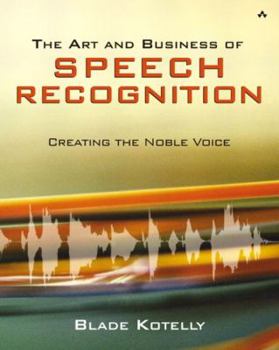The Art and Business of Speech Recognition: Creating the Noble Voice
A concise overview of the growing field of speech recognition systems, from one if its experts. The text explains how voice user interfaces differ from traditional computer user interfaces, and how... This description may be from another edition of this product.
Format:Paperback
Language:English
ISBN:0321154924
ISBN13:9780321154927
Release Date:January 2003
Publisher:Addison-Wesley Professional
Length:208 Pages
Weight:0.40 lbs.
Dimensions:0.5" x 7.2" x 9.4"
Customer Reviews
2 ratings
Achieving robust function with a human spin
Published by Thriftbooks.com User , 21 years ago
Blade Kotelly is the one person in voice design whose attention to the human possibilities of a well-designed voice user interface provides assurance that humanizing our machines will not mechanize humanity. This treatment does not, however, merely try to convince aspiring designers to make their interfaces sound human. It illustrates how a designer can avoid ambiguity, aim for the most graceful styles of retries and error recovery, and how emotive responses can help to implicitly communicate the system's capabilities and limitations without requiring lengthy, explicit descriptions to be read out.Though they are sometimes subtle, the issues and solutions outlined here are broadly explained, and this fosters an appreciation of each and leaves readers better equipped to anticipate where the next one may lie.Kotelly is not delivering a text book which seeks to catalog countless dos and don'ts of design. Rather, he takes what I feel is the proper tack of showing by example how problems arise and listing not one, but a variety of choices a designer could make to avoid the problem. The result is not a series of commandments, but a richly illustrated outline of a well-developed philosophy of design and depiction. The work, I feel, helps the reader to appreciate the impulses that shaped Kotelly's leading work in the field, and to promote in him/her a sense of how they can develop their own affinity for designing systems that work efficiently and are received warmly.If you truly think that a book will help you break into this field or expand your mastery within it, this is an excellent choice. It will inform you and prompt you to think well beyond the content it directly offers. It is perfect to get you thinking more passionately and expansively of what is possible in voice user interface design.
Very lucid; don't be scared off by the subject
Published by Thriftbooks.com User , 21 years ago
Speech recognition as a commercial product is still very new. In 1988, when I was first involved with it, the state of the art did not involve real time capability. You had to record the utterance and then analyse it with a computer. Typically, you also had to train the software with the speaker beforehand. Now, we have commercially available real time, speaker independent products. Some of the largest companies, like United Airlines and ATT, have deployed these, to try and reduce call centre costs, and to improve the user's experience when dialling into such a place. Are you considering installing such software? Of course, you can talk to the vendors. But where can you get objective advice? One possibility is to ask researchers in the field. But they can easily and inadvertantly drown you in jargon, especially if you do not have a technical background. This book attempts to fill that need. You do not need a degree in computer science or maths to understand it. The book does not explain how speech recognition works. Rather the emphasis is at a higher level: Using it in your workplace. The author gives many lucid examples of this. Basically, he outlines a commonsensical appproach that can be understood by anybody. He explains how not to overburden the user with long utterances full of information, but to take advantage of the context of the conversation to omit unnecessary details. He emphasises thorough testing, with a disciplined scaling up to a real life deployment in a call centre. Something that may well have been omitted in other deployments, leading to users gnashing their teeth in frustration at an obtuse dialog, or at busy phone lines. He also discusses why companies should regard this as part of their corporate branding, and how to choose an appropriate "noble" voice as part of that branding. I think the "noble" sounds rather pompous, actually. But that's not his fault! It is a standard phrase in this field, and you too might get used to it.





